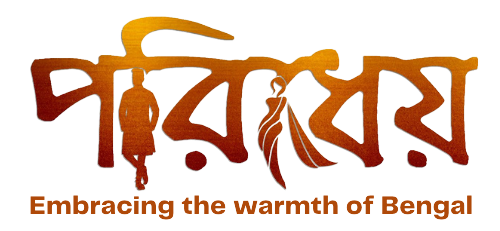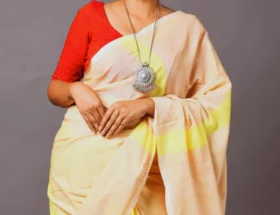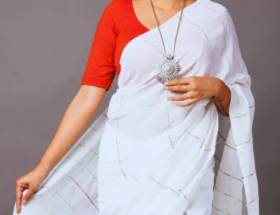Embellishment Works in Indian Ethnic Garments
The mesmerizing world of Indian ethnic garments is adorned with intricate embellishment works that add a touch of opulence and beauty. These embellishments hold immense significance, not only in terms of aesthetics but also culturally and historically. From traditional sarees to lehengas and sherwanis, each garment tells a story through its exquisite embellishments. In this article, we will delve into the artistry and craftsmanship behind these embellishments, exploring their types, techniques, and cultural relevance.
1. Understanding Indian Ethnic Garments
Indian ethnic garments encompass a wide range of attire, including sarees, lehengas, salwar suits, sherwanis, and more. These garments hold deep cultural significance and are often worn during traditional ceremonies, weddings, and festive occasions. They reflect the rich diversity and heritage of India, showcasing exquisite craftsmanship and attention to detail.
2. The Significance of Embellishments Works
Embellishments in Indian ethnic garments serve multiple purposes. They enhance the visual appeal of the attire, elevating it to a whole new level of grandeur. Embellishments also play a crucial role in preserving traditional art forms and supporting skilled artisans who have mastered these intricate techniques over generations.
3. Types of Embellishment works in Indian Ethnic Garments
3.1 Zardozi Embroidery
Zardozi embroidery is a form of metal embroidery that originated in the royal courts of India. It involves the use of gold and silver threads to create intricate designs on fabrics such as silk, velvet, and brocade. Zardozi work adds a regal touch to Indian ethnic garments, making them truly exquisite.
3.2 Kundan and Polki Work
Kundan and Polki work, traditional gem-setting techniques, use uncut diamonds, gemstones, and glass to create stunning designs. They embellish bridal jewelry and garments, adding glamour and luxury.
3.3 Resham and Zari Embroidery
Resham embroidery, also known as silk embroidery, utilizes colorful silk threads to create intricate patterns on fabrics. Zari embroidery, on the other hand, involves the use of metallic threads, typically gold or silver, to add shimmer and elegance to the garments. Indian ethnic wear widely employs both techniques, enhancing the beauty and grace of the garments.
3.4 Mirror and Sequin Embellishment Works
Mirror and sequin embellishments are eye-catching with mirrors of various shapes and sizes intricately stitched onto the fabric, creating a mesmerizing play of light. Artisans sew small, shiny sequins onto the garments, infusing them with a touch of sparkle and glamour.
4. Techniques Used in Embellishment Works
4.1 Hand Embroidery
Hand embroidery is the art of stitching intricate designs onto fabric using a needle and thread. Skilled artisans meticulously create beautiful patterns, often inspired by nature, using various stitches and techniques. Hand embroidery adds a personalized touch to Indian ethnic garments, showcasing the craftsmanship and creativity of the artisans.
4.2 Appliqué Work
Appliqué work involves attaching pieces of fabric, often in contrasting colors or patterns, onto a base fabric to create a design. This technique is widely used in Indian ethnic wear, particularly in regions like Gujarat and Rajasthan. Appliqué’s work adds a vibrant and playful element to the garments, making them visually captivating.
4.3 Beadwork and Stone Setting
Beadwork and stone setting are techniques that involve attaching beads, pearls, and stones onto the fabric. Artisans carefully select and arrange these embellishments to create intricate designs, adding texture and depth to the garments. Beadwork and stone setting create a stunning visual impact, making the garments truly magnificent.
4.4 Thread and Wire Work
Thread and wire work involves using threads and wires to create delicate and intricate designs on the fabric. Artisans skillfully weave threads or shape wires into beautiful patterns, adding a three-dimensional element to the garments. These techniques are often used in combination with other embellishment methods, further enhancing their visual appeal.
5. Cultural Relevance of Embellishment Works in Indian Ethnic Garments
Embellishments hold immense cultural significance in Indian ethnic garments. They reflect the traditions, customs, and art forms of various regions of India. The choice of embellishments and techniques often varies based on the occasion, region, and cultural background. Indian ethnic garments with their embellishments become a medium to celebrate and showcase the rich heritage of the country.
6. How to Care for Embellished Garments
To ensure the longevity of embellished garments, proper care is essential. Here are a few tips to keep in mind:
- Avoid harsh washing methods: Handwashing or dry cleaning is recommended for delicate embellished garments.
- Handle with care: Be gentle while handling garments with heavy embellishments to prevent damage.
- Store carefully: Store embellished garments in a cool, dry place, preferably wrapped in muslin or acid-free tissue paper to prevent any tarnishing or snagging.
- Avoid direct sunlight: Prolonged exposure to sunlight can fade the colors and weaken the embellishments.
Conclusion
Embellishments in Indian ethnic garments are a true testament to the artistry and craftsmanship of skilled artisans. They elevate these garments to a realm of beauty and magnificence, reflecting the cultural richness and traditions of India. Whether it’s the shimmering Zardozi work, the intricate Kundan and Polki embellishments, or the playful mirror and sequin detailing, each embellishment adds its unique charm and allure. Embrace the enchanting world of embellished Indian ethnic garments and revel in the magnificence they offer.
FAQs.
Q1. What are embellishments in Indian ethnic garments?
Embellishment works in Indian ethnic garments refer to decorative elements and techniques used to enhance the beauty and aesthetic appeal of the garments. These embellishments can include intricate embroidery, beading, sequins, stones, mirror work, zari work (metallic threadwork), and more. They are strategically placed on the garments to create patterns, motifs, and designs that reflect the rich cultural heritage of India.
Important information about embellishments in Indian ethnic garments:
- Decorative elements are used to enhance the beauty of the garments.
- Include embroidery, beading, sequins, stones, mirror work, zari work, etc.
- Reflect the rich cultural heritage of India.
Q2. What are the different types of embellishment works used in Indian ethnic garments?
Indian ethnic garments showcase a wide variety of embellishments, each with its unique charm and significance. Some popular types of embellishments used in Indian ethnic garments include:
- Zardozi: Intricate metal embroidery using gold and silver threads, often adorned with precious stones.
- Kundan: Setting precious or semi-precious stones onto the fabric using a gold foil technique.
- Resham: Colorful silk thread embroidery, known for its vibrancy and versatility.
- Gota Patti: Gold or silver ribbon work, creating intricate patterns on fabric.
- Dabka: Metallic wire embroidery, often combined with sequins and beads for added sparkle.
Important information about types of embellishments in Indian ethnic garments:
- Zardozi involves intricate metal embroidery with gold and silver threads.
- Kundan uses a gold foil technique to set stones onto fabric.
- Resham is colorful silk thread embroidery known for its vibrancy.
Q3. How are embellishment works applied to Indian ethnic garments?
Applying embellishment works to Indian ethnic garments requires skilled craftsmanship and attention to detail. The process typically involves:
- Designing: The desired pattern or design is first sketched or traced onto the fabric.
- Embroidery or beading: Skilled artisans meticulously stitch or attach the embellishments onto the fabric using needles, threads, or specialized tools.
- Finishing touches: After the embellishment works are applied, any loose threads or excess materials are trimmed, and the garment is carefully inspected for quality and uniformity.
Important information about applying embellishments to Indian ethnic garments:
- Designing the pattern or design is the first step.
- Skilled artisans meticulously stitch or attach embellishments.
- Finishing touches include trimming loose threads and inspecting for quality.
Q4. What are the significance and cultural symbolism of embellishment works in Indian ethnic garments?
Embellishments in Indian ethnic garments hold great cultural significance and symbolism. They often represent:
- Traditions: Embellishments reflect the rich textile heritage and craftsmanship of various regions in India.
- Festivity and celebration: Elaborate embellishments adorn garments worn during festivals, weddings, and other joyous occasions.
- Status and opulence: The intricacy and richness of embellishments can symbolize wealth, social status, and prestige.
Important information about the significance of embellishments in Indian ethnic garments:
- Reflect the textile heritage and craftsmanship of different regions in India.
- Common in festive and celebratory garments.
- Can symbolize wealth, social status, and prestige.
5. How to care for Indian ethnic garments with embellishment works?
Caring for Indian ethnic garments with embellishments is crucial to maintain their beauty and longevity. Here are some care tips:
- Gentle handling: Handle the garments with care to avoid snagging or damaging the embellishments.
- Spot cleaning: Address stains promptly by gently dabbing the affected area with a mild detergent or fabric cleaner.
- Professional cleaning: For more extensive cleaning, individuals should seek professional dry cleaning services to ensure that delicate embellishments are protected.
- Proper storage: Store the garments in a cool, dry place, away from direct sunlight, to prevent color fading and damage to the embellishments.
Important information about caring for Indian ethnic garments with embellishments:
- Handle with care to avoid damage.
- Spot clean stains and seek professional dry cleaning when needed.
- Store in a cool, dry place away from direct sunlight.
In conclusion, embellishments play a significant role in Indian ethnic garments, enhancing their beauty and reflecting the cultural heritage of India. With their intricate designs and craftsmanship, these embellishments contribute to the uniqueness and elegance of Indian ethnic attire. By understanding the types of embellishments, their application, cultural significance, and care, individuals can appreciate and preserve the artistry of these garments for years to come.






